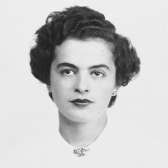
-
Learn More about Manya
- Behind Every Name A Story Read Manya's essay
- Echoes of Memory Read Manya's writings
- First Person Watch Manya share her Holocaust experiences at a First Person program
- Podcast Listen to Manya Friedman discuss her evacuation from Gleiwitz, a subcamp of Auschwitz
Manya Moskowicz Friedman was born December 30, 1925, in Chmielnik, a small town in central Poland whose Jewish community dates back to the 16th century. Her father owned a furniture shop and her mother took care of the home and children. Manya had two younger brothers, David and Mordechai, who was called “Motele.” Manya’s grandparents, aunts, uncles and cousins also lived in the area. She attended public school in the morning and Hebrew school in the afternoon.
In 1938 Manya’s family moved to Sosnowiec, a city located near the German border. There, she had her first experience with antisemitism, when signs appeared urging Polish citizens to boycott Jewish businesses. German troops invaded Poland on September 1, 1939 and three days later, Sosnowiec was occupied. Jewish men, including Manya’s father, were rounded up and the next morning marched to a factory. The prisoners were held overnight without food or water and then selected for local jobs, forced labor, imprisoned in Germany, or executed. Manya’s father was detained to build latrines for the German military and then released. Orders were issued by the Germans in charge that Jews had to turn in all valuables, Jewish merchants must relinquish their businesses, and Jewish children were no longer allowed to attend school. The town’s synagogue was burned down and the neighbors were not allowed to extinguish the fire. Sosnowiec and the surrounding area were then annexed to Germany and new passports were required for all the Jews. An open ghetto was formed. Ration cards were distributed, though they did not provide enough food to survive. All Jews were made to wear identifying armbands and later, the yellow Star of David badge.
In 1941, Manya was forced to work for a German company that produced military uniforms. The following year, the Nazis began deporting Jews from Sosnowiec to the Auschwitz-Birkenau killing center. Manya and her family were temporarily saved from deportation because of their sonderkarts (work permits). In March 1943, she was taken from the uniform factory to the Gogolin transit camp, and later to the Gleiwitz labor camp where she was tattooed with the number 79357, which became her identification. In summer 1943 Manya’s family was deported to Auschwitz when the Sosnowiec ghetto was liquidated.
In January 1945, as the Soviet army approached, the Germans evacuated Gleiwitz. Manya and the other prisoners were sent in open freight cars to the Ravensbrück concentration camp. The trip through the bitter cold lasted ten days, during which time the prisoners had no food and only melted snow to drink. Throughout the journey, Manya shielded a sick friend from being crushed in the overcrowded car. Later, Manya was taken to the Retzow camp, a sub-camp of Ravensbrück. She was liberated by the Swedish Red Cross in late April 1945 and taken to Copenhagen and then on to Malmö. In 1950, she emigrated from Sweden to the United States. Manya was a volunteer at the United States Holocaust Memorial Museum.




